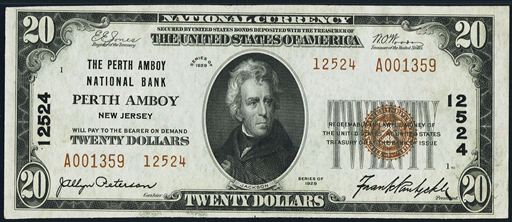The Citizens National Bank Of Evansville
The Citizens National Bank Of Evansville in Indiana printed $7,955,390 dollars worth of national currency. Once a bank issues that much money there really isn’t much room for rare issues. However, there are certainly exceptions to every rule. This national bank opened in 1874 and stopped printing money in 1935, which equals a 62 year printing period. That is considering a long operation period for a national bank. During its life, The Citizens National Bank Of Evansville issued 19 different types and denominations of national currency. We have examples of the types listed below. Your bank note should look similar. Just the bank name will be different. For the record, The Citizens National Bank Of Evansville was located in Vanderburgh County. It was assigned charter number 2188.
We buy all national currency. Please call or email us for a quote. Sales@AntiqueMoney.com
The Citizens National Bank Of Evansville in Indiana printed 2,000 sheets of $5 original series national bank notes. A print range between 1,000 and 2,500 is small. Combine that with something that was printed before 1875 and you can imagine that these notes are few and far between. Each five dollar original series bank note has a spiked red seal. That is pretty much the only design difference between it and later issues. These are really beautiful notes. One neat thing about these is that the back of each note has a vignette of the corresponding state seal. Some of the state seals are very imaginative. Collecting by state seal was very popular early on in the hobby. Today most collectors are more concerned about bank of issue and condition. Serial number one bank notes are also extremely popular.
Original Series $5 National Bank Note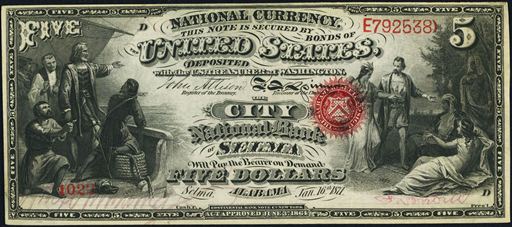
The Citizens National Bank Of Evansville printed 2,350 sheets of $10 original series national bank notes. A print range between 1,000 and 2,500 is small. Combine that with something that was printed before 1875 and you can imagine that these notes are few and far between. These notes were issued during the glory days of the national bank note era. Each $10 bill was pen signed by the president and cashier of the bank. Small towns and large cities both issued these notes. Of course the small town issuers tend to be scarcer today. Prices range from $500 to thousands of dollars (and more if the condition and rarity warrant it). Contact us if you need help valuing your bank note.
Original Series $10 National Bank Note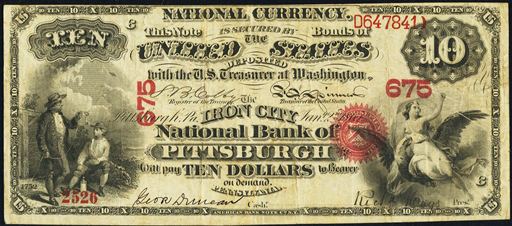
The Citizens National Bank Of Evansville also printed 2,350 sheets of $20 original series national bank notes. That issue number may or may not sound like a lot of sheets depending on your experience with collectible currency. However, all original series $20 bills are rare. The production amount is irrelevant when it comes to values. These seem like common issues until you want to buy one. These just aren’t readily available from rare banks in very fine or better condition. We definitely feel like these are undervalued in today’s market.
Original Series $20 National Bank Note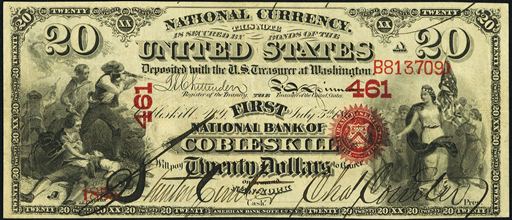
The Citizens National Bank Of Evansville also printed 250 sheets of $5 series of 1875 national bank notes. It is rare to see a sheet output of under 1,000 like this. However, it did happen for some very scarce issuers. Series of 1875 $5 bills are some of the most commonly encountered bank notes from the first charter series. Only the original series $1 bill is more available. Some banks exclusively issued five dollar bills. So if you want an example from one of those banks then you don’t have many options. These notes have a rounded red seal and red serial numbers. They also all have a red charter number.
Series of 1875 $5 National Bank Note
The Citizens National Bank Of Evansville also printed 7,566 sheets of $10 series of 1875 national bank notes. A print range between 5,000 and 10,000 is a pretty high number. But you have to remember we are talking about bank notes from the 1870s and 1880s. Even banks with high issue numbers could be rare today. The two vignettes seen on 1875 $10 bank notes are “Franklin and Electricity” and “America Seizing Lightning”. These notes occasionally confuse novices because the year 1752 is printed on them. That is when Benjamin Franklin discovered electricity. It has nothing to do with when these bank notes were issued. The back of each $10 bill has “DeSoto Discovering the Mississippi.”
Series of 1875 $10 National Bank Note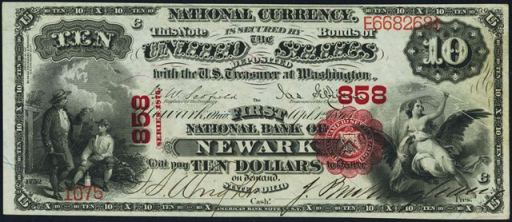
The Citizens National Bank Of Evansville also printed 7,566 sheets of $20 series of 1875 national bank notes. The exact number of series of 1875 $20 national bank notes printed by this bank is good to know. Don’t expect a high number to lower the value or a small number to increase the value. These notes are scarce enough on their own that the stats don’t really matter. Twenty dollars was a lot of money between 1875 and 1901, which is the time period in which these were printed. These just weren’t saved in high numbers.
Series of 1875 $20 National Bank Note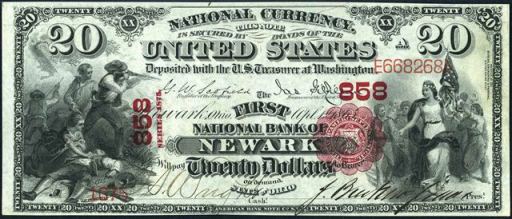
The Citizens National Bank Of Evansville also printed 15,000 sheets of $10 1882 brown back national bank notes. When we start talking about a printing number in the five figure range, then you are likely not dealing with a great rarity. However, the note could certainly still be popular and valuable. There were three $10 bills printed on a single sheet of 1882 brown backs. The design of the bill is similar to all earlier ten dollar national bank notes. The nickname comes from the fact that these bills have a brown seal and brown overprint. Despite saying series of 1882, these were actually printed by some banks up until 1908. The date you see in cursive relates to when the bank first started issuing brown back notes.
Series of 1882 $10 Brown Back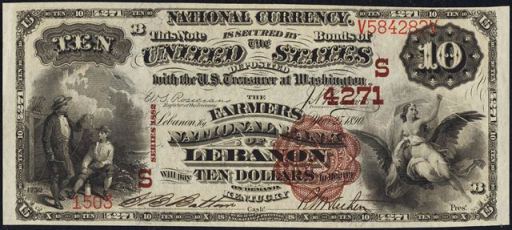
The Citizens National Bank Of Evansville also printed 15,000 sheets of $20 1882 brown back national bank notes. Due to the way brown back sheets were printed we know that the sheet output number equals the number of $20 brown backs printed. When we see a number over 10,000 there is a good chance that the note isn’t going to be especially rare. However, it never hurts to ask. One neat thing about all brown backs is that they each have a different back design based on which state issued them. The back left hand side of the note shows the state seal of which ever state the national bank was located in. Generally speaking, 1882 $20 brown backs are pretty difficult to locate. They typically were printed in small numbers and they don’t have a great survival rate.
Series of 1882 $20 Brown Back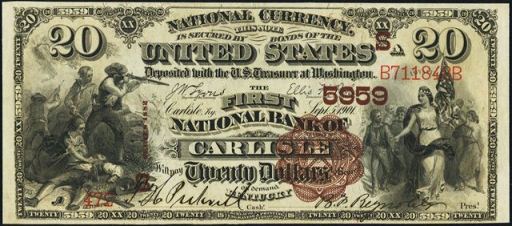
The Citizens National Bank Of Evansville also printed 15,641 sheets of $10 1882 blue seal national bank notes. These were only issued by banks for about ten years (at the most). So it is unusual to see such a high sheet output. This will likely be a common issue unless it is rare signature combination variety. All of these notes say series of 1882 but they were actually printed between 1908 and 1921. So they aren’t quite as old as the dates might suggest. There is also a date on these notes that is between 1888 and 1901. That date is written in cursive text and it represents when the bank was chartered or re-chartered. Some of the so called 1882 value back notes have a chance to be really rare. Most of the earlier notes that say 1882-1908 on the back are likely going to be relatively common. The designs are exactly the same on the front. Each has a blue seal and charter number.
1882 Blue Seal $10 National Bank Note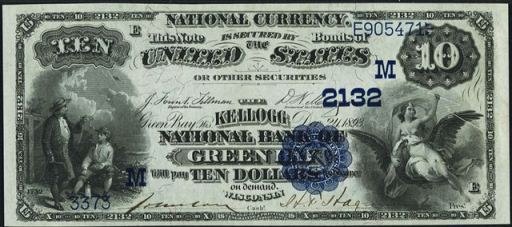
The Citizens National Bank Of Evansville also printed 15,641 sheets of $20 1882 blue seal national bank notes. That is the same number of sheets as the ten dollar denomination. You don’t have to multiply by three to get the exact number of notes issued though. There was only one twenty dollar bill per sheet. As with any national bank note, the exact value is still based on the condition, serial number, and bank of issue.
1882 Blue Seal $20 National Bank Note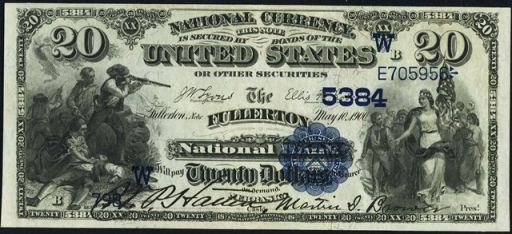
The Citizens National Bank Of Evansville also printed 76,785 sheets of $5 1902 blue seal national bank notes. Sadly, a printing range that high means that these blue seal bank notes from this bank are not going to be extremely rare. Ben Harrison is on the front of all 1902 $5 blue seal bank notes. This happens to be the smallest denomination issued for the 1902 series. Each note is complete with a blue seal and blue charter number. Despite saying series of 1902, these were actually issued by national banks between 1908 and 1928. There are two different types of blue seals. The first type is called a date back and it has “1902-1908” written on the back of the bill. The other type is called a plain back; it does not have the date stamps on the back of the bill. The values for these notes range widely based on condition and the bank of issue.
1902 $5 Blue Seal National Bank Note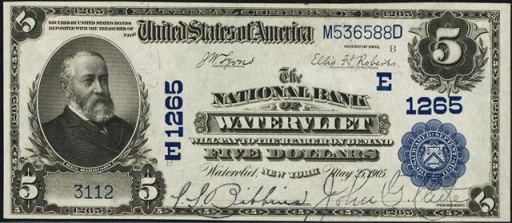
The Citizens National Bank Of Evansville also printed 55,720 sheets of $10 1902 blue seal national bank notes. Sadly, a printing range that high means that these blue seal bank notes from this bank are not going to be extremely rare. 1902 $10 blue seal bank notes all have a portrait of William McKinley on them. Values can range from as little as $40 up to over $10,000. There really is no trick to know what is rare and what is common by just doing an internet search. You really need to work with an expert (like us) in order to determine the value of your specific bank note. There are at least ten different factors than can make some 1902 $10 blue seals worth more than others. We know exactly what to look for and we would be happy to provide a free appraisal and our best offer.
1902 $10 Blue Seal National Bank Note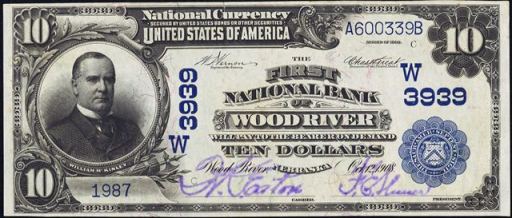
The Citizens National Bank Of Evansville also printed 55,720 sheets of $20 1902 blue seal national bank notes. The same rarity rules for 1902 $10 blue seals also apply to $20 blue seals. Just remember that $20 bills are by nature three times rarer (unfortunately they don’t command a premium over other denominations). Hugh McCulloch is pictured on the front of each bill. Contact us if you need pricing help.
1902 $20 Blue Seal National Bank Note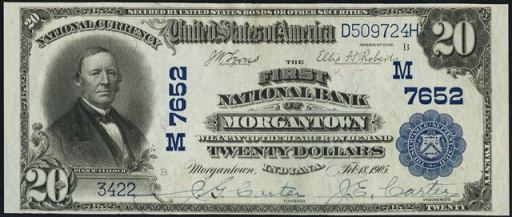
The Citizens National Bank Of Evansville also printed 20,704 sheets of Type1 1929 $5 national bank notes. Sadly, based on a number that high, there is basically no chance for these notes to be especially rare. Every 1929 $5 bill has a portrait of Abraham Lincoln on it. This is also the lowest denomination of small size national currency that any bank issued. All serial numbers end with the letter A and start with a letter between A and F. Remember that you can take the total number of sheets printed and multiply it by six get to the actual number of bank notes printed for this denomination. All small size national bank notes were printed on sheets of six.
Series of 1929 Type1 $5 National Bank Note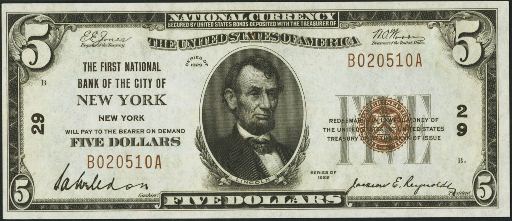
The Citizens National Bank Of Evansville also printed 8,972 sheets of Type1 1929 $10 national bank notes. Sadly, based on a number that high, there is basically no chance for these notes to be especially rare. Each $10 bill from 1929 has a portrait of Alexander Hamilton on it. The black number written vertically is the charter number. The charter number never affects the value; it is just an identifier. The ten dollar type1 national bank note happens to be the single most common national bank note, with over 65,000 known to exist from all banks. Of course each note is valued based on its condition and rarity. Some are very rare.
Series of 1929 Type1 $10 National Bank Note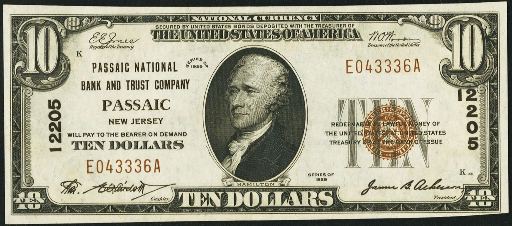
The Citizens National Bank Of Evansville also printed 2,188 sheets of Type1 1929 $20 national bank notes. That is a pretty typical sheet output for a national bank during the small size era. Andrew Jackson is featured on the front of each 1929 $20 bill. Be sure to take note of the serial number on your specific bank note. If it is 000001 then you can expect a nice premium. There is a special market for serial number one bank notes. Of course, even if the number isn’t #1, it could still be collectible and have a high value just based on its condition and rarity alone.
Series of 1929 Type1 $20 National Bank Note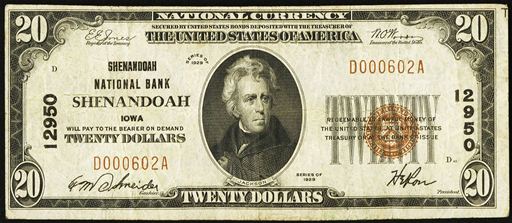
The Citizens National Bank Of Evansville also printed 11,792 individual notes from the type2 1929 $5 national bank note series. This is a pretty typical print run for type2 national bank notes. Values will be across the board based on demand. This was an easy and popular denomination for national banks. Five dollars could buy a lot of different things back in 1929 and the early 1930s. 1929 type2 five dollar bank notes are available in quantities today. However, some notes can be extremely rare. The exact value all depends on the bank of issue and condition. Contact us and we would be happy to give a free appraisal.
Series of 1929 Type2 $5 National Bank Note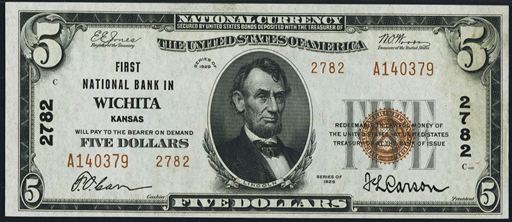
The Citizens National Bank Of Evansville also printed 5,590 individual notes from the type2 1929 $10 national bank note series. This is a pretty typical print run for type2 national bank notes. Values will be across the board based on demand. The easiest way to spot the difference between type1 1929 $10 bills and 1929 type2 $10 bills is in the serial number. Type2 notes have a serial number that ends with a number. 1929 type1 notes have a serial number that ends with the letter A. Generally speaking, these $10 bills are rarer than the earlier type1 issues. However, most collectors don’t pay more for that rarity because they look basically the same.
Series of 1929 Type2 $10 National Bank Note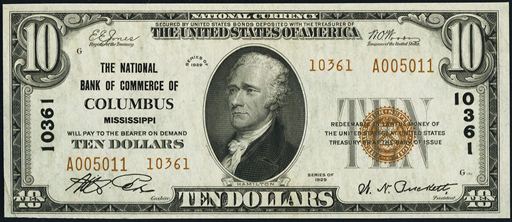
The Citizens National Bank Of Evansville also printed 1,199 individual notes from the type2 1929 $20 national bank note series. That may seem like a high number, but remember that is total notes printed for the denomination, not sheets printed. One of the great things about 1929 type2 $20 national bank notes is that they really aren’t that old and some can be extremely rare. Until the big head $20 series started there really wasn’t much difference between something printed in 1929 and the same bill printed in 1993. We have bought some examples in the past few months that people just found in their change.
Series of 1929 Type2 $20 National Bank Note